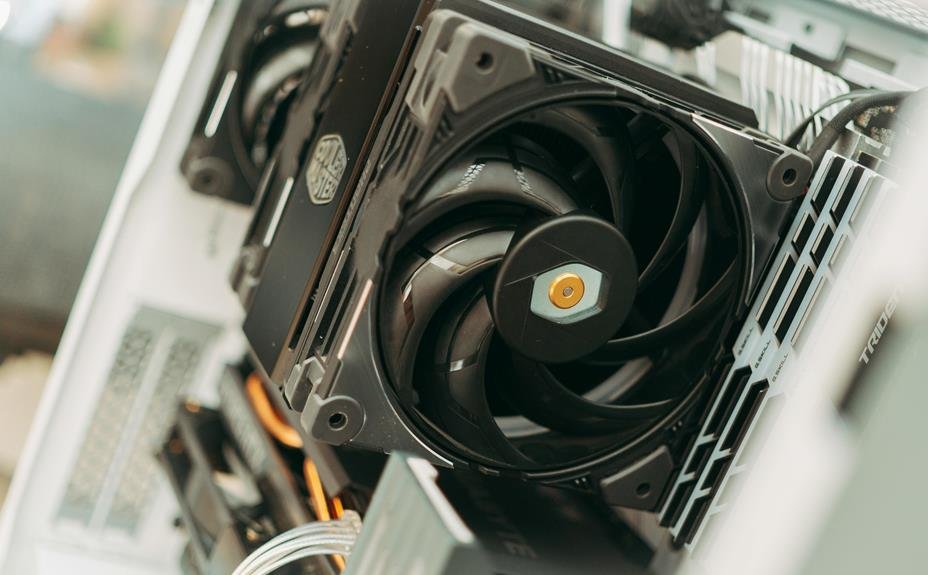
When you push your gaming desktop to its limits with intense gameplay sessions, have you ever wondered how it manages to stay cool under all that pressure? The secret lies in a sophisticated system of cooling mechanisms and clever airflow designs that work tirelessly behind the scenes. But how exactly do these components come together to ensure your desktop remains cool and efficient during those marathon gaming sessions? Let's unravel the mystery behind the cooling wizardry that keeps your gaming rig running smoothly, even when the heat is on.
Cooling Mechanisms Overview
To keep gaming desktops cool during heavy usage, efficient cooling mechanisms play a crucial role. One of the primary components responsible for heat dissipation is the fan. Gaming desktops are equipped with multiple fans strategically placed to ensure proper airflow and cooling. These fans work tirelessly to expel hot air from the system, preventing overheating.
Additionally, heat sinks are vital in cooling gaming desktops. These metal components help absorb and dissipate heat generated by the CPU and GPU, keeping temperatures at manageable levels. By utilizing heat pipes and fins, heat sinks maximize surface area for heat dissipation, contributing to the overall cooling efficiency of the system.
Moreover, thermal paste is another critical element in the cooling process. It's applied between the CPU/GPU and the heat sink to improve heat transfer. This paste fills in microscopic gaps between the two surfaces, enhancing thermal conductivity and aiding in heat dissipation.
Advanced Cooling Systems
When considering advanced cooling systems for gaming desktops, incorporating liquid cooling can significantly enhance thermal management efficiency. Liquid cooling systems utilize a network of tubes filled with coolant to draw heat away from the components more effectively than traditional air cooling methods. By transferring heat to a radiator where it can dissipate, liquid cooling systems help maintain lower temperatures within the system even under heavy workloads. These systems are often more efficient at cooling high-performance components like CPUs and GPUs, making them popular among gamers and enthusiasts looking to push their hardware to the limit without risking overheating.
Additionally, some advanced cooling systems feature customizable settings that allow users to adjust fan speeds and coolant flow rates to meet specific thermal demands. This level of control can help optimize cooling performance based on the workload or ambient temperature, ensuring that the system remains stable and reliable during intense gaming sessions. Overall, incorporating liquid cooling into a gaming desktop can provide a quieter, more efficient cooling solution that helps extend the lifespan of the hardware.
Efficient Airflow Designs
Incorporating efficient airflow designs into gaming desktops plays a crucial role in maintaining optimal operating temperatures for high-performance components. Effective airflow designs ensure that cool air is efficiently brought in and hot air is effectively expelled from the system. Components such as CPU, GPU, and RAM generate heat during heavy usage, and proper airflow helps dissipate this heat, preventing thermal throttling and potential damage to the hardware.
Cases with strategically placed intake and exhaust fans help create a smooth flow of air throughout the system, preventing heat buildup in specific areas. Additionally, cable management within the case can also contribute to improved airflow by reducing obstructions and allowing air to circulate freely. Some gaming desktops feature specialized airflow pathways or ducts to direct air towards hot components, enhancing cooling performance.
Cooling Strategies for Heavy Usage
During heavy usage, ensure your gaming desktop stays cool by implementing effective cooling strategies. One key strategy is to regularly clean the internal components of your desktop to prevent dust buildup, which can obstruct airflow and lead to overheating. Make sure to use compressed air to remove dust from fans, heatsinks, and vents.
Additionally, consider upgrading your CPU cooler to a more efficient one, especially if you overclock your processor for better performance. Investing in high-quality thermal paste can also improve heat transfer between the CPU and the cooler.
Another effective cooling strategy is to optimize your fan setup by ensuring a balanced airflow within the case. Position fans strategically to create a steady flow of cool air entering the case and hot air exiting it.
Lastly, if your gaming desktop still struggles with cooling during heavy usage, you may want to explore advanced cooling solutions such as liquid cooling systems for enhanced heat dissipation.




